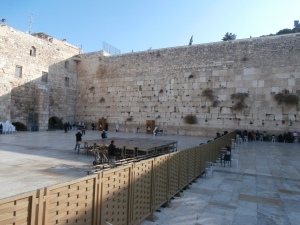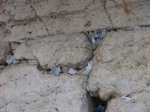(The fourth in a series of posts in which I reflect on my “group study pilgrimage” to Israel, February 10-20. Earlier posts here , here , and here.)
The first time I made it to the Western Wall a torrential rainstorm had just begun. It was still an amazing place to be, but somehow not very spiritual. It was more like my first visit to the Coliseum in Rome or the Taj Mahal – there was the surreal feeling of being in a photograph somehow; I had seen those places so many times before in pictures and NOW HERE I WAS. I had the same experience the first time I walked onto the Jeopardy set. Yep, not very spiritual.
It didn’t help that I had misinterpreted the division of the wall . . . I thought one side was Jews and the other was Gentiles. If I had paid more attention I would have avoided being shooed away by the woman attendant guarding what I too late realized was the women’s side of the men/women divide.
Things were a little different when I returned with our group of pilgrim pastors the next day. Sunlight and blue skies reigned. Worshipers (and tourists) lined the structure, some wrapped in white and blue prayer shawls, many bowing spasmodically as they prayed, some simply leaning into the wall, allowing it to support the weight of their bodies and the burden of their prayers. At intervals along the wall stood wooden boxes containing the Torah; as our guide told us, the presence of Scripture transformed a location from a place of gathering to a place of prayer.
I approached the wall (on the correct side this time) and placed my hands on it. I prayed. I read the page in my pocket notebook where I had scrawled the names of folks back home I had promised remember in prayer on this trip. Then I wrote a name on another page, ripped it out, and tossed it into one of the many gaps between stones. There it joined thousands upon thousands of other printed pleas crammed into the crevices, where they would remain until one of the two times a year the notes are collected and buried on the Mount of Olives.
The Western Wall (also known as the Wailing Wall because dew covers the stones at night, “weeping” it is believed will stop when the Messiah returns) is a holy place for Jewish folks. It is as close as they can get to the Holy of Holies in what used to be the Temple (destroyed in 70 AD). Jerusalem is a city of many walls, but the only one that remains from the Second Temple of Jesus’ time is this retaining wall built by Herod the Great.
Although I prayed deeply as I stood there with my hands on the wall, my experience was clearly not as deeply felt as that of the Jewish folks around me. For me as a Christian, the Holy of Holies is not a place, it is a person. I don’t have to go to Jerusalem in order to approach the Holy of Holies, I only have to pray wherever I am. He is not just with me, he lives in me.
Early in the journey, our guide jokingly said, “Welcome to Israel, the only place where God is not a long distance call.”
There is some heartfelt belief behind that quip, among Christians as well as Jews. Some of us pastors on the pilgrimage were asked by our parishioners to pray for them, specifically in Israel. Maybe the prayers would somehow mean more there?
The truth is that we were no “closer to God” in Israel – even in Jesus’ hometown of Nazareth, even at or on the Sea of Galilee upon which he walked, even in his birthplace at Bethlehem . . even at the Western Wall – than we are in our homes and our schools and our workplaces. Or even in our churches.
But . . . the experience of God in Israel was different somehow.
One day we had a few moments on top of the Mount of the Beatitudes to spread out and meditate on what (may have – it’s not certain that is the “right” mount) happened there. I sat on a rock overlooking the Sea of Galilee. Just below on the side of the hill banana trees grew where our guide had just said, “Imagine a crowd of people there instead of the trees. You can see how everyone could have seen and heard Jesus as he shared the Beatitudes and the rest of the Sermon on the Mount.” Bathed in brilliant sunlight, I read Matthew 5, 6, and 7 – the Sermon on the Mount. They were the same words I had heard many times before, but they resonated differently. They took on a spatiality.
That illustrated something else our guide had said – this experience would give us a “third dimension” to our understanding of the Bible. And it did.
So although the Mount of the Beatitudes may not be the exact spot where Jesus delivered the Sermon on the Mount, it was definitely somewhere around there. The Church of the Nativity may not be built on the precise location of Jesus’ birth in Bethlehem, but it is certainly, as another guide said, “in the neighborhood.” Each of those places and the other sites we visited were opportunities to be steeped in the stories of the Bible, particularly the life and ministry of Jesus, in ways that engaged our hearts and our heads . . . and our bodies.
In other words, although we might not have been always (or even often) walking in the exact “footsteps of Jesus,” on our pilgrimage we gained new understandings of what those footsteps might have been like as well as what they meant. One day we stood on a balcony with the Mount of Olives on one side and the Temple Mount on the other with the Kidron Valley in between. Our guide traced Jesus’ route on Holy Week, down from the Mount of Olives and into the valley, past the huge cemetery that was there even then with each grave a reminder of his impending death, then up toward the temple. Three dimensions indeed!
On that same day, we walked down, down, down into the dungeon below the Church of St. Peter Gallicantu (literally “rooster’s crow”). We crowded into the dark, stone-walled space. Perhaps it was the dungeon beneath the High Priest’s palace where Jesus was held on Maundy Thursday. Perhaps not. But the precise location became irrelevant as one of our leaders began to read the unrelenting lament that is Psalm 88 from above us. In part . . .
I am overwhelmed with troubles
and my life draws near to death.
I am counted among those who go down to the pit;
I am like one without strength.
I am set apart with the dead,
like the slain who lie in the grave,
whom you remember no more,
who are cut off from your care.
It was those immersive, multi-sensory experiences that made the pilgrimage so powerful. Although I would not say my faith “grew” as a result, my faith was certainly enhanced; or maybe “expanded” is a better word. Adding that “third dimension” will certainly benefit my devotional life. And, even more important, it can’t help but augment my sharing of the Gospel with others.






Praise God who walks with us – past, present and future! Amen.
LikeLike
Amen!
LikeLike
I have been reliving my visit to Israel with Jerry, when reading your blogs. It was so wonderful to walk where Jesus walked. We put prayers in the wall, also.
LikeLike
I’m so glad you had that experience with Jerry! And I’m glad the blog can help you relive those wonderful memories.
LikeLike
Thanks for the opportunity to experience this trip without leaving our homes…will have to renew my passport! Karen Cox
LikeLike
Thanks for reading, Karen! And definitely renew your passport !
LikeLike